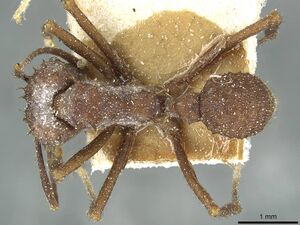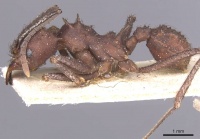Acromyrmex hispidus
| Acromyrmex hispidus | |
|---|---|

| |
| Scientific classification | |
| Kingdom: | Animalia |
| Phylum: | Arthropoda |
| Class: | Insecta |
| Order: | Hymenoptera |
| Family: | Formicidae |
| Subfamily: | Myrmicinae |
| Tribe: | Attini |
| Genus: | Acromyrmex |
| Species: | A. hispidus |
| Binomial name | |
| Acromyrmex hispidus Santschi, 1925 | |
| Subspecies | |
| |
Identification
Distribution
Latitudinal Distribution Pattern
Latitudinal Range: 25.68015° to -34.6°.
| North Temperate |
North Subtropical |
Tropical | South Subtropical |
South Temperate |
- Source: AntMaps
Distribution based on Regional Taxon Lists
Neotropical Region: Bolivia (type locality), Uruguay.
Distribution based on AntMaps
Distribution based on AntWeb specimens
Check data from AntWeb
Countries Occupied
| Number of countries occupied by this species based on AntWiki Regional Taxon Lists. In general, fewer countries occupied indicates a narrower range, while more countries indicates a more widespread species. |

|
Estimated Abundance
| Relative abundance based on number of AntMaps records per species (this species within the purple bar). Fewer records (to the left) indicates a less abundant/encountered species while more records (to the right) indicates more abundant/encountered species. |

|
Biology
|
Association with Other Organisms
 Explore: Show all Associate data or Search these data. See also a list of all data tables or learn how data is managed.
Explore: Show all Associate data or Search these data. See also a list of all data tables or learn how data is managed.
- This species is a host for the phorid fly Myrmosicarius longipalpis (a parasitoid) (Quevillon, 2018) (encounter mode primary; direct transmission; transmission outside nest).
Castes
Images from AntWeb
   
| |
| Syntype of Acromyrmex hispidus formosus. Worker. Specimen code casent0912455. Photographer Will Ericson, uploaded by California Academy of Sciences. | Owned by NHMB, Basel, Switzerland. |
   
| |
| Syntype of Acromyrmex hispidus. Worker. Specimen code casent0913867. Photographer Z. Lieberman, uploaded by California Academy of Sciences. | Owned by NHMB, Basel, Switzerland. |
Nomenclature
The following information is derived from Barry Bolton's Online Catalogue of the Ants of the World.
- hispidus. Acromyrmex hispidus Santschi, 1925a: 376 (w.) BOLIVIA.
- Type-material: 3 syntype workers.
- Type-locality: Bolivia: Conraditi (C. Lizer & L. Delétang).
- Type-depository: NHMB.
- Zolessi & Abenante, 1974: 154 (q.m.); Goni, et al. 1983: 365 (k.).
- Status as species: Weber, 1938b: 205; Kusnezov, 1953b: 338; Kusnezov, 1956: 35 (in key); Gonçalves, 1961: 142; Kempf, 1972a: 12; Zolessi & Abenante, 1974: 154; Zolessi & Abenante, 1977: 84; Zolessi, et al. 1988: 4; Cherrett & Cherrett, 1989: 50; Brandão, 1991: 323; Bolton, 1995b: 55; Bezděčková, et al. 2015: 114.
- Distribution: Bolivia, Peru, Uruguay.
- Current subspecies: nominal plus fallax, formosus.
Description
Karyotype
- See additional details at the Ant Chromosome Database.
 Explore: Show all Karyotype data or Search these data. See also a list of all data tables or learn how data is managed.
Explore: Show all Karyotype data or Search these data. See also a list of all data tables or learn how data is managed.
- 2n = 38, karyotype = 2M+6SM+16ST+14A (Uruguay) (Goni et al., 1983).
References
- Barros, L.A.C., Aguiar, H.J.A.C., Teixeira, G.C., Souza, D.J., Delabie, J.H.C., Mariano, C.S.F. 2021. Cytogenetic studies on the social parasite Acromyrmex ameliae (Formicidae: Myrmicinae: Attini) and its hosts reveal chromosome fusion in Acromyrmex. Zoologischer Anzeiger 293, 273–281 (doi:10.1016/j.jcz.2021.06.012).
- Cardoso, D. C., Cristiano, M. P. 2021. Karyotype diversity, mode, and tempo of the chromosomal evolution of Attina (Formicidae: Myrmicinae: Attini): Is there an upper limit to chromosome number? Insects 1212, 1084 (doi:10.3390/insects12121084).
- Goñi, B.; Zolessi, L. C. de; Imai, H. T. 1984 [1983]. Karyotypes of thirteen ant species from Uruguay (Hymenoptera, Formicidae). Caryologia 36: 363-371 (page 365, karyotype described)
- Santschi, F. 1925a. Revision du genre Acromyrmex Mayr. Rev. Suisse Zool. 31: 355-398 (page 376, worker described)
- Zolessi, L. C. de; Abenante, Y. P. de. 1974 [1973]. Nidificación y mesoetología de Acromyrmex en el Uruguay III. Acromyrmex (A.) hispidus Santschi, 1925 (Hymenoptera: Formicidae). Rev. Biol. Urug. 1: 151-165. (page 154, queen, male described)
References based on Global Ant Biodiversity Informatics
- Bezdeckova K., P. Bedecka, and I. Machar. 2015. A checklist of the ants (Hymenoptera: Formicidae) of Peru. Zootaxa 4020 (1): 101–133.
- Bonetto A. A. 1959. Las hormigas "cortadoras" de la Provincia de Santa Fé (generos: Atta y Acromyrmex). Santa Fé, Argentina: Ministerio de Agricultura y Ganadería (Dirección General de Recurzos Naturales), 79 pp.
- Brandao, C.R.F. 1991. Adendos ao catalogo abreviado das formigas da regiao neotropical (Hymenoptera: Formicidae). Rev. Bras. Entomol. 35: 319-412.
- Calcaterra L. A., F. Cuezzo, S. M. Cabrera, and J. A. Briano. 2010. Ground ant diversity (Hymenoptera: Formicidae) in the Ibera nature reserve, the largest wetland of Argentina. Ann. Entomol. Soc. Am. 103(1): 71-83.
- Cuezzo, F. 1998. Formicidae. Chapter 42 in Morrone J.J., and S. Coscaron (dirs) Biodiversidad de artropodos argentinos: una perspectiva biotaxonomica Ediciones Sur, La Plata. Pages 452-462.
- Culebra Mason S., C. Sgarbi, J. Chila Covachina, J. M. Pena, N. Dubrovsky Berensztein, C. Margaria, and M. Ricci. 2017. Acromyrmex Mayr (Hymenoptera: Formicidae: Myrmicinae): species distribution patterns in the province of Buenos Aires, Argentina. Rev. Mus. Argentino Cienc. Nat. 19(2) 185-199.
- Escalante Gutiérrez J. A. 1993. Especies de hormigas conocidas del Perú (Hymenoptera: Formicidae). Revista Peruana de Entomología 34:1-13.
- Escalante J. A. 1975. Hormigas de la Provincia de la Convencionm Cusco. Revista Peruana de Entomologia 18:125-126.
- Farji Brener A. G., and A. Ruggiero. 1994. Leaf-cutting ants (Atta and Acromyrmex) inhabiting Argentina: patterns in species richness and geographical range sizes. Journal of Biogeography 21(4): 391-399.
- Fernández, F. and S. Sendoya. 2004. Lista de las hormigas neotropicales. Biota Colombiana Volume 5, Number 1.
- Gonçalves C. R. 1961. O genero Acromyrmex no Brasil (Hym. Formicidae). Stud. Entomol. 4: 113-180.
- Kempf, W.W. 1972. Catalago abreviado das formigas da regiao Neotropical (Hym. Formicidae) Studia Entomologica 15(1-4).
- Kusnezov N. 1953. La fauna mirmecológica de Bolivia. Folia Universitaria. Cochabamba 6: 211-229.
- Kusnezov N. 1956. Claves para la identificación de las hormigas de la fauna argentina. Idia 104-105: 1-56.
- Kusnezov N. 1978. Hormigas argentinas: clave para su identificación. Miscelánea. Instituto Miguel Lillo 61:1-147 + 28 pl.
- Pignalberi C. T. 1961. Contribución al conocimiento de los formícidos de la provincia de Santa Fé. Pp. 165-173 in: Comisión Investigación Científica; Consejo Nacional de Investigaciones Científicas y Técnicas (Argentina) 1961. Actas y trabajos del primer Congreso Sudamericano de Zoología (La Plata, 12-24 octubre 1959). Tomo III. Buenos Aires: Librart, 276 pp.
- Santos Lopes J. F., N. Martins dos Reis Hallack, T. Archanjo de Sales, M. Silva Brugger, L. F. Ribeiro, I. N. Hastenreiter, and R. da Silva Camargo. 2012. Comparison of the Ant Assemblages in Three Phytophysionomies: Rocky Field, Secondary Forest, and Riparian ForestA Case Study in the State Park of Ibitipoca, Brazil. Psyche doi:10.1155/2012/928371
- Santschi F. 1925. Revision du genre Acromyrmex Mayr. Revue Suisse de Zoologie 31: 355-398.
- Santschi F. 1933. Fourmis de la République Argentine en particulier du territoire de Misiones. Anales de la Sociedad Cientifica Argentina. 116: 105-124.
- Ulyssea M.A., C. E. Cereto, F. B. Rosumek, R. R. Silva, and B. C. Lopes. 2011. Updated list of ant species (Hymenoptera, Formicidae) recorded in Santa Catarina State, southern Brazil, with a discussion of research advances and priorities. Revista Brasileira de Entomologia 55(4): 603-611.
- Vittar, F. 2008. Hormigas (Hymenoptera: Formicidae) de la Mesopotamia Argentina. INSUGEO Miscelania 17(2):447-466
- Vittar, F., and F. Cuezzo. "Hormigas (Hymenoptera: Formicidae) de la provincia de Santa Fe, Argentina." Revista de la Sociedad Entomológica Argentina (versión On-line ISSN 1851-7471) 67, no. 1-2 (2008).
- Weber N. A. 1938. The biology of the fungus-growing ants. Part IV. Additional new forms. Part V. The Attini of Bolivia. Rev. Entomol. (Rio J.) 9: 154-206.
- Zolessi L. C. de; Y. P. de Abenante, and M. E. Philippi. 1989. Catálogo sistemático de las especies de Formícidos del Uruguay (Hymenoptera: Formicidae). Montevideo: ORCYT Unesco, 40 + ix pp.
- de Zolessi, L.C., Y.P. de Abenante and M.E. Phillipi. 1989. Catalago Systematico de las Especies de Formicidos del Uruguay (Hymenoptera: Formicidae). Oficina Regional de Ciencia y Technologia de la Unesco para America Latina y el Caribe- ORCYT. Montevideo, Uruguay

